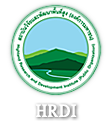The Royal Project Area
The north of Thailand covers an area of 17 million hectares, 33 percent of the Kingdom’s total land area of 51 million hectares. As one travels to the northern part of Thailand, gently sloping land become uplands and uplands become highlands. Indeed, the north of Thailand includes a mountainous area which can represent difficulty upon difficulty and needs a lot of attention. This area can be a locus of poverty, they conspire to keep the borders of these countries uncontrollable, they offer hideouts for rebels and dissidents and they were often times a location for opium production. Highland areas are generally inhospitable. The mountainous area of South East Asia is home to dozens of different ethnic groups who in general live there because they have nowhere else to go. Because forested mountains cannot be policed, these people have fairly free movement between the countries over which these mountains range. The Royal Project and the Highland Research and Development Institute (HRDI) have successfully dealt with those challenges in the north of Thailand. These 17 million hectares are divided as follows: there are three million hectares of lowland, which is flat or fairly flat; there are five million hectares of upland, which is sloping, and hill-covered land below 500 meters in elevation. The remaining nine million hectares of land are ‘highland’ land above 500 meters. These highland areas are a mix of hills, mountains and flat land, or what are called mountain plateau.
The Royal Project Operation Area has a total of 28 centers located in five provinces, including Chiang Mai, Chiang Rai and mae Hong Son with an average altitude of 800 meters above the sea. Those Hill Tribe centers are mainly located in remote rural areas away from civilization. The Royal Project and HRDI’s projects focus on preventing erosion, deforestation and the fragility of the highland ecosystem. One of the fundamental reasons why the Hill tribes were so poor is that highland regions are not well-suited for agriculture, such as the fragility of highland soils, the lack of adequate tree cover and functioning watersheds which cause erosion effects. Broadly speaking, the later the Hill Tribes arrived in Thailand, the further up into the highlands they would be forced to settle. Therefore the Karen typically lived at the lower elevations, the Yao, Akha, Lahu and Lisu live at intermediate elevations and the Hmong lived at the highest elevations. This pattern no longer holds so clearly, as migration into Thailand by most ethnic groups has continued unabated, and techniques of land development have allowed the government and the Royal Project as well as HRDI to create new agricultural land where none existed before. We can mainly distinguish between three different kinds of highland areas:
Area One – Altitude 1000 m
Most of this area is so called mountain plateau and a complex of mountains and valleys usually with a lot of steep forest. Great plains can be found with complex slope systems along the creek valley or hillside areas. The highland region itself has a moderate soil fertility which is slightly acidic with an average rainfall of approximately 1518.5 mm per year and an average temperature of 19.7 Celsius. Hill Tribe farmers in these centers are particularly Karen, Hmong, Lahu and Chinese Hong who nowadays with the help and efforts of the Royal Project Foundation focus on sustainable agricultural processes. Main projects are rice fields as an alternative to opium cultivation, the agricultural importance of fruit during the winter season (plums, pear, persimmon, plum and peaches that can grow on a slope or hillside) and growing annual crops such as vegetables and cut flowers that can be planted on a slope near water facilities.
Area Two – Moderate Elevation with an Altitude between 800 – 1000 m
This is an area with diverse mountain and valley complexes mainly covered by steep cultivated land which is flat and has creeks along the slopes. Some have wavy undulating slopes. The highland region has a moderate soil fertility which is slightly acidic with an average rainfall of about 1299.5 mm per year and an average temperature of 22.7 Celsius. Hill Tribe farmers of these areas are mainly Karen and Lahu. It is popular to grow plants without rotation whereas tea is native to some specific areas.
Area Three – Low Altitude between 400 – 800 m
The terrain of this area is mostly hilly whereas you can find a plateau in the valley and some lower hills. The Weather is much hotter and more humid than the first two groups, especially during the winter and summer season where the average temperature is 23.6 Celsius and the average rainfall is 1480.5 mm per year. Main problems of this region are still deforestation through traditionally practiced swidden or ‘slash-and-burn’ practices. The Royal Project and HRDI try to focus on training courses and reforestation as well as watershed fountain projects. Hill Tribe farmers in these centers are mainly Karen, Hmong and Lahu who grow upland rice for their living. Their agricultural income rises from fruit trees including mango, longan, pomelo, persimmon, passion flowers (including Chrysanthemus Gladiolus and anthurium flowers) and vegetables, such as lettuce, Chinese cabbage, Japanese cucumber and Japanese pumpkin. Corn crops are corn, soybeans, peanuts whereas raising animals for own household consumption and nutrition has also been encouraged. In addition, farmers also have an additional income through employment and various craft.
 |
|
| Royal Project Extention Area >> | |


